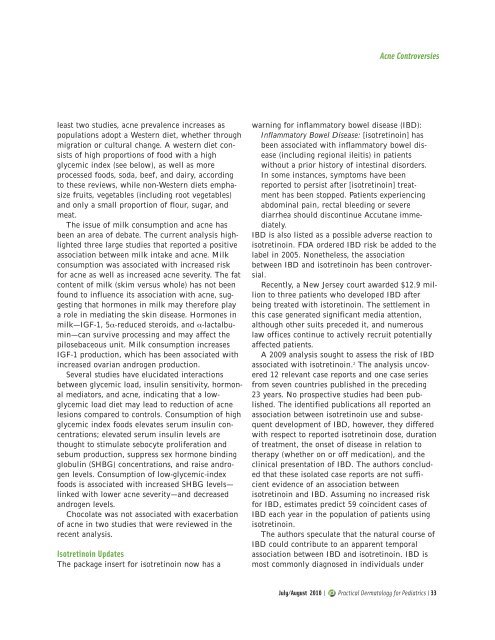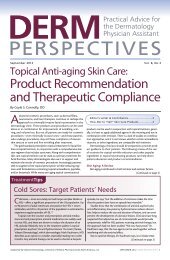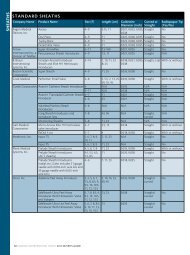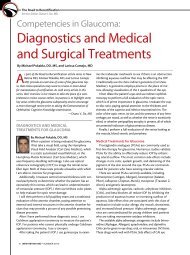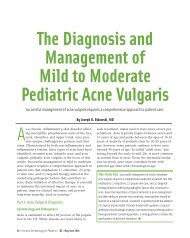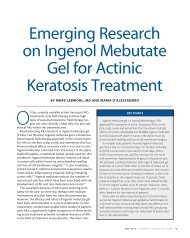Acne Controversies: An Update Based on Recent Findings
Acne Controversies: An Update Based on Recent Findings
Acne Controversies: An Update Based on Recent Findings
You also want an ePaper? Increase the reach of your titles
YUMPU automatically turns print PDFs into web optimized ePapers that Google loves.
<str<strong>on</strong>g>Acne</str<strong>on</strong>g> <str<strong>on</strong>g>C<strong>on</strong>troversies</str<strong>on</strong>g><br />
least two studies, acne prevalence increases as<br />
populati<strong>on</strong>s adopt a Western diet, whether through<br />
migrati<strong>on</strong> or cultural change. A western diet c<strong>on</strong>sists<br />
of high proporti<strong>on</strong>s of food with a high<br />
glycemic index (see below), as well as more<br />
processed foods, soda, beef, and dairy, according<br />
to these reviews, while n<strong>on</strong>-Western diets emphasize<br />
fruits, vegetables (including root vegetables)<br />
and <strong>on</strong>ly a small proporti<strong>on</strong> of flour, sugar, and<br />
meat.<br />
The issue of milk c<strong>on</strong>sumpti<strong>on</strong> and acne has<br />
been an area of debate. The current analysis highlighted<br />
three large studies that reported a positive<br />
associati<strong>on</strong> between milk intake and acne. Milk<br />
c<strong>on</strong>sumpti<strong>on</strong> was associated with increased risk<br />
for acne as well as increased acne severity. The fat<br />
c<strong>on</strong>tent of milk (skim versus whole) has not been<br />
found to influence its associati<strong>on</strong> with acne, suggesting<br />
that horm<strong>on</strong>es in milk may therefore play<br />
a role in mediating the skin disease. Horm<strong>on</strong>es in<br />
milk—IGF-1, 5α-reduced steroids, and α-lactalbumin—can<br />
survive processing and may affect the<br />
pilosebaceous unit. Milk c<strong>on</strong>sumpti<strong>on</strong> increases<br />
IGF-1 producti<strong>on</strong>, which has been associated with<br />
increased ovarian androgen producti<strong>on</strong>.<br />
Several studies have elucidated interacti<strong>on</strong>s<br />
between glycemic load, insulin sensitivity, horm<strong>on</strong>al<br />
mediators, and acne, indicating that a lowglycemic<br />
load diet may lead to reducti<strong>on</strong> of acne<br />
lesi<strong>on</strong>s compared to c<strong>on</strong>trols. C<strong>on</strong>sumpti<strong>on</strong> of high<br />
glycemic index foods elevates serum insulin c<strong>on</strong>centrati<strong>on</strong>s;<br />
elevated serum insulin levels are<br />
thought to stimulate sebocyte proliferati<strong>on</strong> and<br />
sebum producti<strong>on</strong>, suppress sex horm<strong>on</strong>e binding<br />
globulin (SHBG) c<strong>on</strong>centrati<strong>on</strong>s, and raise androgen<br />
levels. C<strong>on</strong>sumpti<strong>on</strong> of low-glycemic-index<br />
foods is associated with increased SHBG levels—<br />
linked with lower acne severity—and decreased<br />
androgen levels.<br />
Chocolate was not associated with exacerbati<strong>on</strong><br />
of acne in two studies that were reviewed in the<br />
recent analysis.<br />
Isotretinoin <str<strong>on</strong>g>Update</str<strong>on</strong>g>s<br />
The package insert for isotretinoin now has a<br />
warning for inflammatory bowel disease (IBD):<br />
Inflammatory Bowel Disease: [isotretinoin] has<br />
been associated with inflammatory bowel disease<br />
(including regi<strong>on</strong>al ileitis) in patients<br />
without a prior history of intestinal disorders.<br />
In some instances, symptoms have been<br />
reported to persist after [isotretinoin] treatment<br />
has been stopped. Patients experiencing<br />
abdominal pain, rectal bleeding or severe<br />
diarrhea should disc<strong>on</strong>tinue Accutane immediately.<br />
IBD is also listed as a possible adverse reacti<strong>on</strong> to<br />
isotretinoin. FDA ordered IBD risk be added to the<br />
label in 2005. N<strong>on</strong>etheless, the associati<strong>on</strong><br />
between IBD and isotretinoin has been c<strong>on</strong>troversial.<br />
<strong>Recent</strong>ly, a New Jersey court awarded $12.9 milli<strong>on</strong><br />
to three patients who developed IBD after<br />
being treated with istoretinoin. The settlement in<br />
this case generated significant media attenti<strong>on</strong>,<br />
although other suits preceded it, and numerous<br />
law offices c<strong>on</strong>tinue to actively recruit potentially<br />
affected patients.<br />
A 2009 analysis sought to assess the risk of IBD<br />
associated with isotretinoin. 2 The analysis uncovered<br />
12 relevant case reports and <strong>on</strong>e case series<br />
from seven countries published in the preceding<br />
23 years. No prospective studies had been published.<br />
The identified publicati<strong>on</strong>s all reported an<br />
associati<strong>on</strong> between isotretinoin use and subsequent<br />
development of IBD, however, they differed<br />
with respect to reported isotretinoin dose, durati<strong>on</strong><br />
of treatment, the <strong>on</strong>set of disease in relati<strong>on</strong> to<br />
therapy (whether <strong>on</strong> or off medicati<strong>on</strong>), and the<br />
clinical presentati<strong>on</strong> of IBD. The authors c<strong>on</strong>cluded<br />
that these isolated case reports are not sufficient<br />
evidence of an associati<strong>on</strong> between<br />
isotretinoin and IBD. Assuming no increased risk<br />
for IBD, estimates predict 59 coincident cases of<br />
IBD each year in the populati<strong>on</strong> of patients using<br />
isotretinoin.<br />
The authors speculate that the natural course of<br />
IBD could c<strong>on</strong>tribute to an apparent temporal<br />
associati<strong>on</strong> between IBD and isotretinoin. IBD is<br />
most comm<strong>on</strong>ly diagnosed in individuals under<br />
July/August 2010 | Practical Dermatology for Pediatrics | 33


